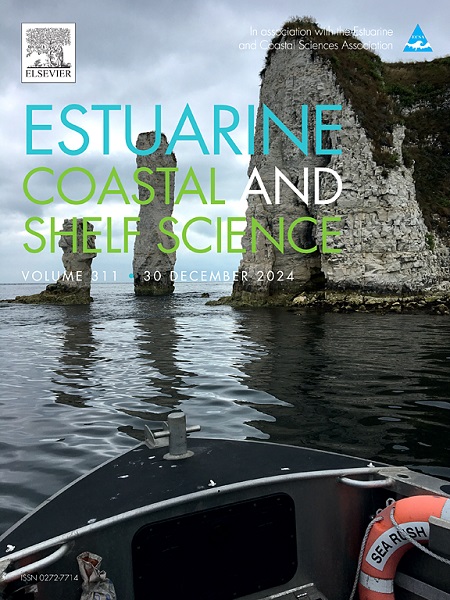西非几内亚比绍的潮汐放大和扭曲
IF 2.6
3区 地球科学
Q1 MARINE & FRESHWATER BIOLOGY
引用次数: 0
摘要
了解潮汐行为对几内亚比绍来说至关重要,几内亚比绍是一个脆弱的低洼沿海地区,是西非潮差最高的国家。本文的目的是通过分析潮汐的特征及其放大和失真的机理来改进潮汐预报。为此,我们使用了一个高分辨率的沿海海洋模型(CROCO),该模型经过了潮汐测高和新的潮汐计数据的验证。我们提出并分析了主要成分的共潮图。由于宽大陆架上的共振,这种放大首先发生在沿海水域,并在河口加强,特别是在Geba海峡,潮汐差可达到7米。这在一定程度上是由于潮汐能量的汇集,它从南部穿过比加戈斯群岛。半日潮也有四分之一波长的共振(模式0)。在较小的河口(如布巴),没有漏斗,因此潮汐只能通过与反射波的共振来放大。由于在格巴和布巴分别与1模态和0模态共振的溢出潮的产生,也证明了强烈的潮汐不对称性。不对称和斯托克斯漂移与格巴海峡的推进波(导致潮汐设置)有关,使其成为一个复杂的局部系统,在河口以退潮为主,可能有助于比加戈斯群岛的持续增长。其他以驻波为特征的较小河口更典型地以洪水为主。所有这些都影响了几内亚比绍沿海和河口水域的停留时间。本文章由计算机程序翻译,如有差异,请以英文原文为准。
Tidal amplification and distortion in Guinea-Bissau, West Africa
Understanding tidal behavior is of paramount importance in Guinea-Bissau, a vulnerable low-lying coastal zone with the highest tidal range of any West African country. Our aim is to improve tide prediction by analyzing its characteristics and mechanisms of amplification and distortion. To this end, we use a high-resolution coastal ocean model (CROCO) validated by tidal altimetry and new tide gauge data. We present and analyze the cotidal charts of the main constituents. The amplification occurs first in coastal waters due to resonance over the broad shelf and strengthens in the estuaries, especially in the Geba Channel where a tidal range of 7 m can be reached. This is due, in part, to the funneling of tidal energy, which travels from the south through the Bijagos Archipelago. There is also a resonance of a quarter wavelength (mode 0) for semi-diurnal tides. In smaller estuaries (e.g., Buba), there is no funneling, so the tides can only be amplified by resonance with reflected waves. A strong tidal asymmetry is also demonstrated due to the generation of overtides that are resonant with mode 1 at Geba and mode 0 at Buba. The asymmetry and Stokes drift associated with the progressive waves in the Geba Channel (leading to tidal setup) make it a complex local system with ebb dominance at the mouth, perhaps contributing to the continuous accretion in the Bijagos archipelago. Other smaller estuaries characterized by standing waves are more classically flood-dominated. All this affects the residence time of water along the coasts and estuaries of Guinea Bissau.
求助全文
通过发布文献求助,成功后即可免费获取论文全文。
去求助
来源期刊
CiteScore
5.60
自引率
7.10%
发文量
374
审稿时长
9 months
期刊介绍:
Estuarine, Coastal and Shelf Science is an international multidisciplinary journal devoted to the analysis of saline water phenomena ranging from the outer edge of the continental shelf to the upper limits of the tidal zone. The journal provides a unique forum, unifying the multidisciplinary approaches to the study of the oceanography of estuaries, coastal zones, and continental shelf seas. It features original research papers, review papers and short communications treating such disciplines as zoology, botany, geology, sedimentology, physical oceanography.

 求助内容:
求助内容: 应助结果提醒方式:
应助结果提醒方式:


